
Magnesite floor survey
By: admin | Posted on: January 23, 2018
I recently had an enquiry regarding a small puddle on a hallway floor, which was presumed to be a penetrating damp issue. On quizzing my client it was also noted that this was mainly observed first thing in the morning, and also sometimes when there was no rain present during the night. I was asked to investigate, to find the cause, and also offer a solution.
The property in questions is a 1950’s semi detached house, of cavity wall construction.
The carpet had recently been removed from the front entrance hallway because it had become stained. The floor in question is red in colour, and when tapped sounded hollow in places, but consistently as in the sound of the depth, indicative of a floor type screed/covering. Very high readings were noted when the floor was tested with a damp meter, all of this pointed to me that this is possibly a magnesite floor. With a typical magnesite floor you would expect consistent very high readings using a damp meter.
Unfortunately on the day of the survey, the visible puddle wasn’t evident, but as somebody that has previous experience with this issue first hand I was pretty certain I knew what the issue was, it was just a question of proving it……
The client was contacted, as I needed to confirm asbestos wasn’t present in the flooring, I know of some cases where it is present in magnesite flooring. Tests confirmed there was none present, and a re-visit was booked – so on this visit I hoped to prove the issue, and also inspect the floor to work out repair costs.
First of all I used a humidifier, this is basically the opposite to a dehumidifier, this basically creates lots of humidity and can quickly exaggerate a problem so I can see an issue rather than presume. The area was tented off and the humidifier was switched on, being impatient I kept opening the porch door to see if water was pooling …it wasn’t! I knew it would take a fair amount of time, but in the end it took about 45 minutes for this to occur, unfortunately because of the amount of humidity I didn’t get the video footage showing it actually occur…I was gutted.
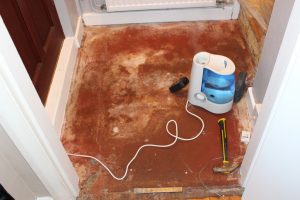
The below picture actually shows the water on the surface, although not a great shot!
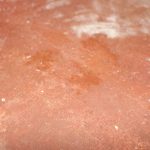
This shows the magnesite floor opened up, it was around 25mm in depth in the places inspected.
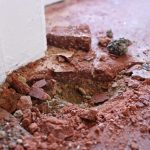
Now a layperson may wonder why the puddle occurred, and was it a condensation issue?
Condensation was definitely not the cause, this was completely eliminated using our equipment.
Now magnesite floors are basically very hygroscopic. Hygroscopic salts absorb water from the air; a good example is that of sodium chloride, common salt, which under humid conditions crystals become ‘sticky ‘clump together. However, there is an extreme of hygroscopic-deliquescent-where the salts absorb so much water that affectively they dissolve in themselves and thus we have a solution. The point at which deliquescent occurs depends on the particular salt. For example common salt is hygroscopic at 75% relative humidity but increased this to 85% plus and keep it there then it becomes deliquescent and therefore liquid. Once in liquid form the salts become mobile and can move away from their point of origin.
Different salts become deliquescent at different humidities. Some like calcium chloride and many of the calcium salts deliquesce at very low humidities: others such as sodium chloride become deliquescent at much higher humidities. Whatever the case there are occasionally conditions where the material becomes physically damp solely due to the contamination by such salts.
As there was no floor covering present, and the night time temperature drops, subsequently the relative humidity increases (high relative humidity in this case = deliquescent) – this is why the problem was only viewed first thing in the morning.
Tips for surveyors
If you see this type of floor colour, think magnesite, this is the only colour I’ve personally ever seen. I’ve been told that in other locations that there is greens and brown. This floor in particular was very soft when poked, although some I have found are harder, when in better condition. When checking solid floors through carpet coverings on pre purchase surveys, if you get very high readings, you could put your client on notice, as the repairs can be very expensive especially if asbestos is present and it needs to be removed.
Also remember to get it tested for asbestos, this is a cheap process and has to be carried out.
The two below pictures show macro images taken of two different magnesite floors, as you can see the make up material is completely different.
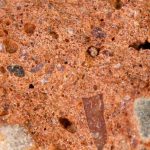
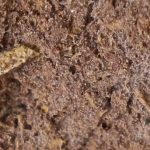
Magnesium oxychloride or, as it is frequently called magnesite composition flooring consist essentially of a mixture of burnt magnesite with fillers and pigments which is gauged with the solution of magnesium chloride. The latter combines with the burnt magnesite to form a strong cement. The fillers generally consist of sawdust and/ wood flour and, sometimes a portion of talk, asbestos or sand.
The materials for use in the manufacture of the composition are to some extent covered by British standard 776–1938, but at present the specification does not closely define the properties of the burnt magnesite, although it is hoped that this will be done later. The pigments covered by British Standard 1014–1942.
The materials are calcined magnesite, magnesium chloride, fillers (wood flour, sawdust and ground silica), and pigments. For calcined magnesite, quality, composition, density, fineness, setting time, and strength are specified; and for magnesium chloride, quality and composition. Quality, moisture content, resin content, fineness, and matter soluble in water are specified for fillers. Pigments are described, and closes deal with colour and staying power, matter soluble in water, and other extract.
The code of practice for the laying of magnesite compositional flooring, published by the building industry is National Council in 1938, describes in detail the requirements the subfloors and the methods of mixing, laying and maintaining the composition, and it also specifies tests for the mixes used. It is essential that this code should be followed if satisfactory results are to be obtained. Among the requirements laid down the following may be noted: the sub floor shall be rigid, dry I’m not too porous. Good quality concrete made with dense aggregate forms a very suitable base, but weak concretes as those made with porous aggregate are unsuitable. Concrete slabs in contact with the ground must contain a damp course. When used in proximity to metal such as I’m steel reinforced concrete bases, rigid precautions must be taken against corrosive action of the magnesium chloride. The best results are obtained only when the floor is laid by skilled operatives with efficient supervision. Subject to the provisions magnesite composition is suitable for use on many types of subfloor e.g. concrete, steel, stone, work or wood.
Magnesium oxychloride floors require regular maintenance if long life and good appearance are required. The maintenance however, need not be high. If surface treatment with a wax polish or linseed oil at six monthly intervals will probably prove quite satisfactory in most cases. They should be kept clean by scrubbing with warm water only. A mild soap may occasionally be used, but no single washing powder containing soda should be employed.
The floor if properly maintained, is free from testing and is reasonably easy to keep clean. It is moderately warm possesses good wearing qualities that is rather hard and noisy. It is unaffected by mineral oils and greases or vegetable fats; when wax polished it tends to become slippery; the floor is well adapted to forming coved skirtings and should be proof against bug infestation.
In the past the reputation of magnesite composition floors has suffered by reason of numerous failures , but there is little doubt that high proportion of these were due to the floors being laid at cut prices with unskilled labour and insufficient supervision. As examples of the defects which have arisen due to these causes the following may be cited; severe cracking and low wear resistance; insufficient protection of metalwork leading to severe corrosion with its consequent troubles; disintegration due to laying the floor finish on unsuitable base, the base being to weak or not containing damp proof membrane; severe ” sweating” of the floor generally due to the use of too wet a mix and access of magnesium chloride; trouble due to damp walls owing to severe contamination with magnesium chloride resulting from careless mixing.
It was to overcome such troubles as these that the code of practice was designed, and is therefore felt that, with the appropriate precautions there is no reason why the material should not take a useful place in post-war housing.
The most suitable situation for its use would be living rooms, bedrooms and halls. It is not recommended for kitchens or bathrooms or where it may be exposed to high humidity or damp conditions. If, however, it is found necessary to use this floor for such situations the surface should be adequately protected by wax polishing or oil treatment.
If you need a survey or advice contact us on 01225 769215.
